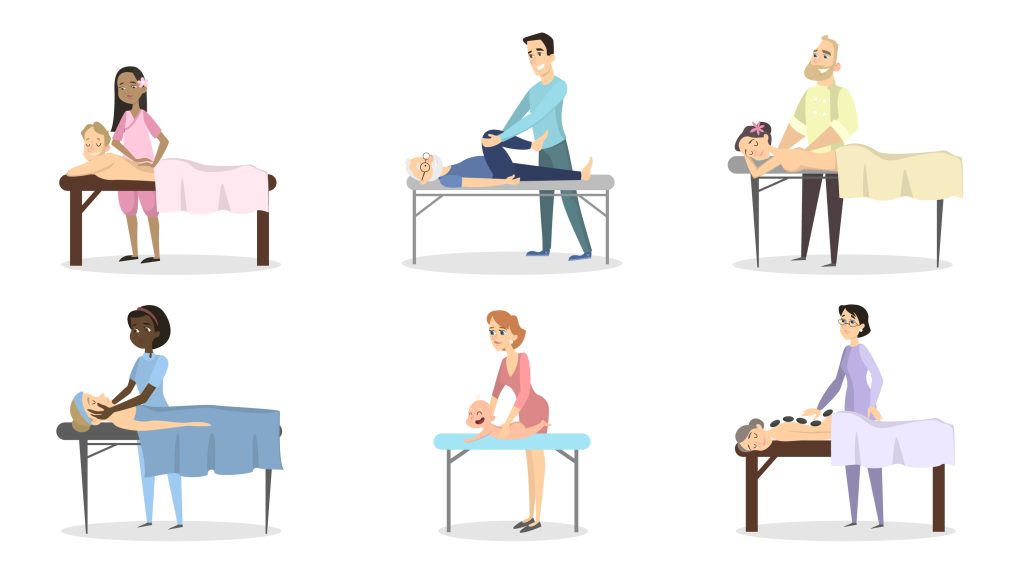Have you ever wondered how often you should schedule a massage? Well, in this article, we will explore the ideal frequency for indulging in some much-needed relaxation and rejuvenation. Whether you’re seeking relief from chronic pain, reducing stress, or simply treating yourself, finding the right balance is key. So, keep reading to discover the answer to the question, “How often should you go get a massage?”

This image is property of www.inyourhometherapy.com.
Benefits of Regular Massage
Reduces muscle tension
Regular massage therapy is a proven method for reducing muscle tension. Whether you’re an athlete, a desk worker, or just someone who experiences daily physical stress, the repetitive motions and pressures of massage can help to relax and release the tension built up in your muscles. When your muscles are tense, it can not only cause discomfort and pain, but it can also limit your range of motion and hinder your performance in physical activities. By incorporating regular massage into your routine, you can improve your muscle flexibility and reduce the risk of injury.
Improves blood circulation
Another significant benefit of regular massage is its ability to improve blood circulation throughout your body. As the massage therapist applies pressure and manipulates your muscles, it promotes the flow of blood to the targeted areas. This increased blood circulation delivers essential nutrients and oxygen to your muscles, organs, and tissues, enabling them to function optimally. Improved blood circulation can also aid in the removal of metabolic waste products, reducing the risk of inflammation and enhancing your overall health.
Promotes relaxation
In today’s fast-paced and stressful world, finding moments of pure relaxation can be challenging. That’s where regular massage comes in. Massage therapy has long been recognized as a powerful tool for promoting relaxation and relieving stress. The soothing touch of a skilled massage therapist can calm your nervous system, lower your heart rate, and reduce the production of stress hormones such as cortisol. Through the release of endorphins, often referred to as “feel-good” hormones, regular massage can leave you feeling rejuvenated and in a state of deep relaxation.
Relieves stress and anxiety
Stress and anxiety have become all too common in modern life, impacting both our mental and physical well-being. Regular massage offers a natural, drug-free approach to managing and reducing these symptoms. Massage therapy activates the body’s relaxation response, triggering a cascade of physiological changes that help counteract the effects of stress. By reducing muscle tension, promoting deep breathing, and calming the mind, massage can alleviate the physical and emotional symptoms associated with stress and anxiety. Incorporating regular massage into your routine can provide ongoing relief and support your overall mental health.
Factors to Consider

This image is property of chopra.brightspotcdn.com.
Physical health
When determining how often you should get a massage, it’s important to take into account your physical health. If you have specific health conditions or injuries, consulting with a healthcare professional or a licensed massage therapist is crucial. They can provide valuable insight and recommendations tailored to your individual needs. Certain physical health conditions may require more frequent massages to address specific symptoms and promote healing.
Activity level
Your level of physical activity is another factor to consider when deciding how often to get a massage. If you’re an athlete or someone who engages in regular intense physical activity, massage can play a crucial role in maintaining your performance and preventing injuries. Athletes often benefit from more frequent massages to aid in muscle recovery, improve flexibility, and enhance overall athletic performance. On the other hand, if your activity level is relatively low, you may not require massages as frequently.
Stress levels
Stress can take a toll on both your mental and physical well-being. Regular massage can be an effective tool to manage and reduce stress levels. If you lead a high-stress lifestyle, such as a demanding job or significant life changes, more frequent massages may be beneficial. Lowering stress levels through regular massage can have a positive impact on your overall health and quality of life.

This image is property of pressmodernmassage.com.
Budget
While the benefits of regular massage are undeniable, it’s also essential to consider your budget when determining how often you should go for a massage. Massage therapy sessions can vary in price, depending on factors such as location, therapist experience, and session duration. It’s essential to find a frequency that fits within your budget without compromising the quality of care you receive. Consider exploring package deals or membership options offered by reputable massage therapy establishments to make regular massage more affordable.
Recommended Frequency for Different People
Athletes and active individuals
For athletes and active individuals, receiving regular massages can be an integral part of their training and recovery routine. It is recommended that athletes and those engaging in intense physical activity schedule massages weekly or even multiple times a week, especially during periods of increased training or competition. Regular massages can aid in muscle recovery, prevent injuries, and enhance performance.

This image is property of static.wixstatic.com.
People with chronic pain
Individuals suffering from chronic pain conditions such as fibromyalgia, arthritis, or back pain can greatly benefit from regular massage therapy. Depending on the severity of their symptoms, it is often recommended that they receive massages at least once or twice a week to manage their pain levels effectively. Consistent massages can help reduce muscle tension, improve joint mobility, and provide relief from chronic pain.
Pregnant women
Pregnancy brings numerous physical and emotional changes to a woman’s body. Regular massage during pregnancy can be a safe and effective way to alleviate discomfort, reduce stress, and promote overall well-being. Expectant mothers are advised to consult with their healthcare provider before starting regular massage therapy. In most cases, they can benefit from a massage once or twice a month, especially during the second and third trimesters.
Office workers and sedentary individuals
Office workers and individuals with sedentary lifestyles often experience muscle stiffness, poor posture, and tension in their neck, shoulders, and back. Regular massages can help alleviate these symptoms and improve overall well-being. It is recommended that office workers and sedentary individuals schedule massages every two to four weeks to counteract the negative effects of prolonged sitting and repetitive movements.

This image is property of images.squarespace-cdn.com.
Healthy individuals seeking relaxation
Even if you don’t have any specific health concerns, regular massage can still be a valuable addition to your self-care routine. Healthy individuals seeking relaxation and general well-being can benefit from a monthly or bi-monthly massage. This frequency allows for consistent stress relief, improved blood circulation, and better overall physical and mental health.
Signs That You May Need More Frequent Massages
Chronic muscle pain
If you experience persistent muscle pain that lasts more than a few days and interferes with your daily activities, it may be a sign that you need more frequent massages. Chronic muscle pain can indicate muscle imbalances, overuse, or underlying health conditions that could benefit from regular therapeutic interventions.
Stress and anxiety
When stress and anxiety become overwhelming and start affecting your quality of life, more frequent massages can provide much-needed relief. If you find it challenging to calm your mind, relax your body, or manage stress-induced physical symptoms, increasing the frequency of massages can help restore balance and promote overall well-being.
Poor posture and muscle imbalances
Sitting for prolonged periods, engaging in repetitive activities, or maintaining poor posture can lead to muscle imbalances and postural issues. If you notice recurring discomfort, tension, or imbalances in your muscles, you might benefit from more frequent massages. A skilled massage therapist can help identify areas of tension, alleviate muscle imbalances, and restore proper postural alignment through regular treatments.
Signs That You May Need Less Frequent Massages
Muscle soreness and fatigue
Muscle soreness and fatigue are common after intense physical activity or a deep tissue massage session. However, if your muscles regularly feel sore, tired, or fatigued, it may indicate that you need less frequent massages. Your body requires time to recover and rebuild, so reducing the frequency of massages can allow for proper healing.
Limited financial resources
Massage therapy is an investment in your health and well-being. If your budget is tight or you have limited financial resources, it may be necessary to reduce the frequency of your massages. It’s important to find a balance between the frequency that meets your needs and what you can afford. Remember, even occasional massages can still provide benefits and support your overall well-being.
No specific issues to address
If you’re in good health, relatively active, and not experiencing any specific issues or discomfort, you may not need frequent massages. Sometimes, maintaining a consistent self-care routine that includes occasional massages for relaxation and stress relief is sufficient. Listen to your body and pay attention to its signals to gauge when you may need to schedule a massage.
Personal Preferences and Time Availability
Making massage a regular part of your self-care routine
Incorporating regular massages into your self-care routine requires prioritization and commitment. Consider carving out dedicated time in your schedule for massages, whether it’s once a week, bi-weekly, or monthly. Treating massage as an essential part of your overall wellness can yield significant benefits for your physical and mental health.
Scheduling massages based on your schedule and lifestyle
When determining the frequency of your massages, it’s essential to consider your schedule and lifestyle. Assess how much time you can realistically commit to regular massage and plan accordingly. While some individuals may have the luxury of scheduling massages more frequently, others with busier schedules may opt for monthly or bi-monthly sessions. Find a schedule that works for you and ensures you can consistently reap the benefits of regular massage.
In conclusion, the frequency of massages varies depending on a range of factors such as physical health, activity level, stress levels, and budget. Assessing your specific needs and consulting with professionals can help you determine how often you should go for a massage. Remember to listen to your body, prioritize self-care, and make regular massage a part of your journey towards improved well-being.
